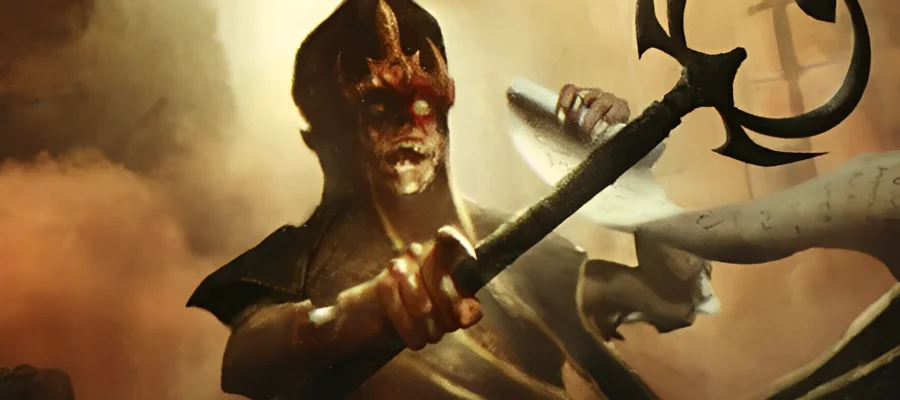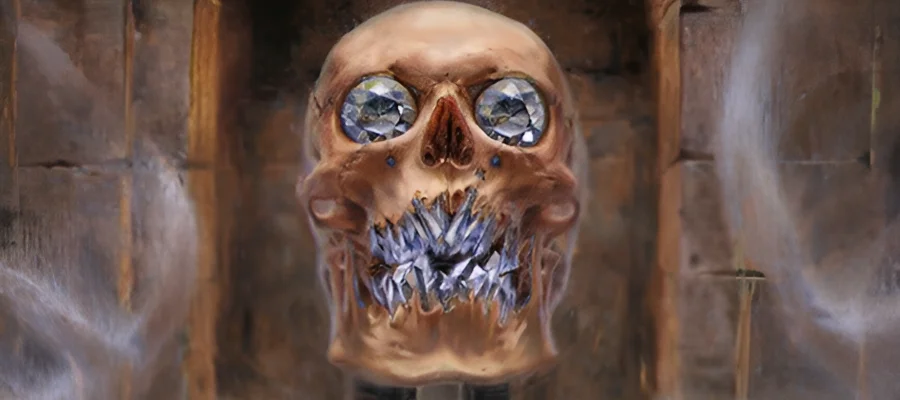Welcome once again to a spoooky post about stuff that’s in D&D! That’s right, it’s time to once again look at an older, historical edition of D&D that may just be serving as my excuse to look back to the early 00s and late 1990s and consider what tabletop gaming thought of as normal and cool, and go ‘wow that’s messed uuup’! But this time with a spooooky twist!
We’re going to talk about liches!
In the simplest way of describing it, a lich is an undead kind of boss monster, where the body you deal with can be killed, but as long as a special item is not destroyed, the lich reconstitutes shortly. You might recognise it as a bit like a Dracula story, where a vampire is killed but returns to life very conveniently if the proper ritual isn’t done to deal with it. This particular idea is pretty cool, where you can tell a story where, yes, violence is needed to claim power from the oppressor, but the actual resolution of the problem is not just stopping with the act of violence.
In D&D, typically, liches are spellcasters, wizards that get so good at spellcasting, and so invested in becoming good at spellcasting, that they eventually do a magical ritual to stick their soul in an object. This object is then the thing that needs destroying to kill the lich. That object, as one of the most important things in the world, needs to be kept safe, and thus creates a set of incentives and expressions for the lich. Do you put the object somewhere near you, so you can keep an eye on it and defend it? Do you put it somewhere remote, so anyone who kills you will have no chance to find it before you come back to life and exact punishment? Can you make it a puzzle? Is it emotionally important to you?
Liches did exist in earlier editions of course, but for me, historically, they seem most significantly part of 3rd edition. Particularly, for some inexplicable reason, the 3rd edition description of Liches included instructions for becoming one, and made it a process that sounded both annoying and attainable. Liches weren’t a monster category any more in that edition but rather something that, if you wanted, you could become, because it was just another way of being. Oh, sure, you might have to be evil and give up some magical objects, but the idea of becoming a lich and spending resources to do it was right there in the 3e monster book. Don’t ask how it interacted with level adjustment though, that was goofy.
Part of the thing with liches, at least as you might know the term these days, is that even though the idea they work from isn’t exactly new or anything, this idea of the lich as someone who has stored their soul in an object for longevity seems to link back to the D&D representation of it. It’s not an idea unheard of — you probably heard of The Painting of Dorian Grey, right? — but these days, the idea of a powerful wizard who stores their soul somewhere has that same connection to the idea of a lich, seemingly thanks to D&D. The word, referring to an undead wizard who’s hard to kill specifically ties back to D&D, and the modern media that grows out of that love of D&D stuff brings it along.
That’s probably why Arthas, the character from World of Warcraft and possibly one of the most widely-known undead villains of modern media, is known as The Lich King – it wasn’t like that term was meaningful without the background of D&D. There’s a villain in the TV series Adventure Time that is known as just ‘The Lich,’ and that term is treated with seriousness enough that it supports itself. There’s another mainstream media example, but it’s related to Harry Potter and quite frankly, I don’t care.
None of that, though, is the scariest thing about Liches. The idea of a D&D thing spreading into the general culture, the horror of what they represent distorting and pressing itself onto an entire genre of media? That’s just cultural exchange. It’s not even like the lich itself represents something particularly worrying, like a racist stereotype, right?
Right?
Alright, well, there is the origin of the term used for these soul storage devices liches use. You might notice, if you’re a keen reader, that I didn’t use the word ‘phylactery’ once so far. This is because this is the term where things get uncomfortable about liches.
There’s always an uncomfortable place to come from when I start talking about ‘Jewish stuff.’ This is because there are some Jewish things that are cultural and some that are religious and some thing at are straight up lies from people like my family about what they ‘really’ mean by things. When I say ‘phylacteries are a Jewish thing,’ understand that that’s a phrase that comes with some caveats and some specifics, some of which I’m not really equipped to explain as an expert.
Specifically, if you’re an expert on this kind of terminology, you might know that largely, they’re not called phylacteries. They’re called tefillin, which refers to small black leather boxes, with leather straps, which hold particular verses of the Torah. They’re used for prayers, and that’s all you need for a general overview before we start getting into discussions of who and who doesn’t use them and why. You know, the first paragraph of Wikipedia stuff. You should check them out, they’re interesting.
Anyway, the thing is, these things are sometimes referred to as phylacteries – it’s a Greek term, and it’s used in the new testament, and in the Jewish Encyclopedia of 1906, at least, Phylacteries and Tefillin were treated as synonyms. I understand these days the more common term is Tefillin, which may relate to there being a mainstream modern culture of speaking Hebrew, as opposed to using more ‘Christian’ words.
Anyway, point is, this is not a word that was kicking around widely. You had to be a bit of a dork to know what they were, and know this specific term. You had to be, say, a heavily invested Jehovah’s Witness mythology nerd, who read a lot and didn’t really regard other faiths and their rituals as being acceptable in public spaces. You know, you had to be a person like Gary Gygax.
I don’t think Gary Gygax specifically went: Ah! I need a term for these undead wizards, time to dig around and find something that shows Jewish people what I think of their tefillin. I think he looked around for obscure words that fit the needs and didn’t think twice about what it meant when he used a Jewish religious observance term for his Evil Wizard Soul Storage Box.
Kinda sucks though. Maybe we don’t call them that any more, eh? It’s not like the word has any use in English aside from these two spots.



